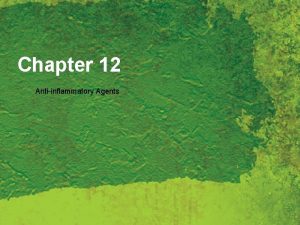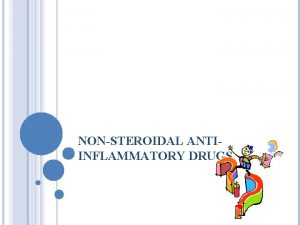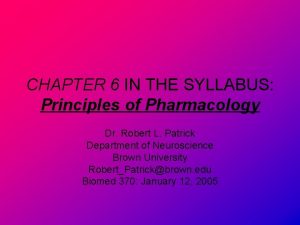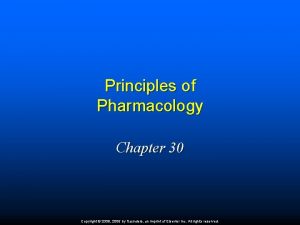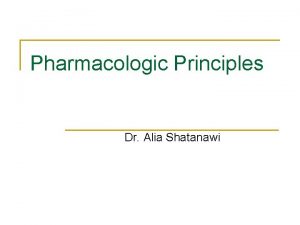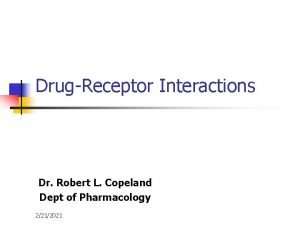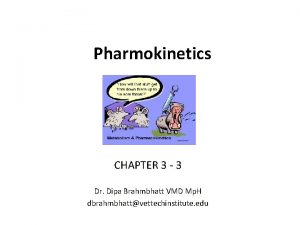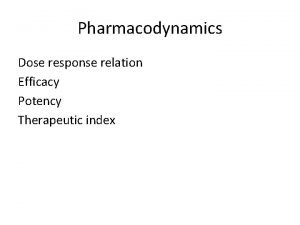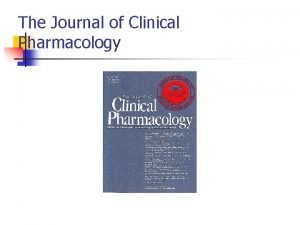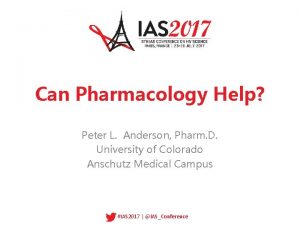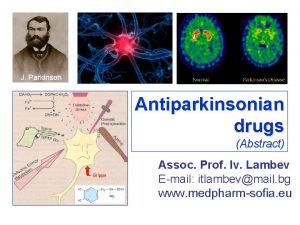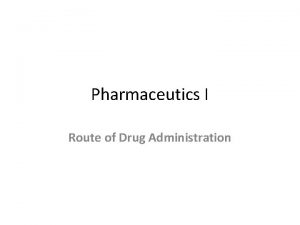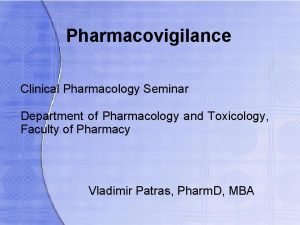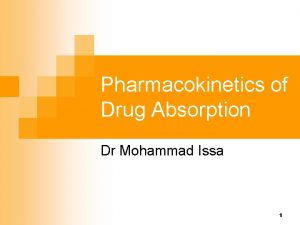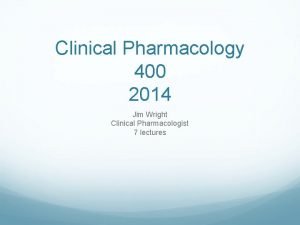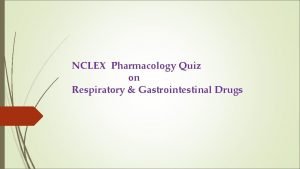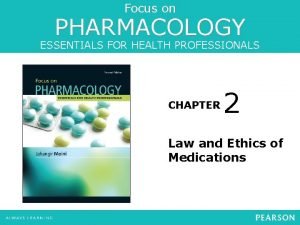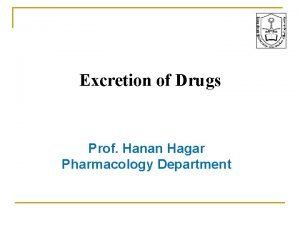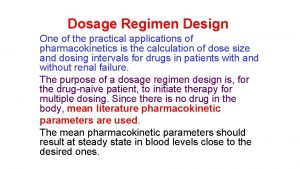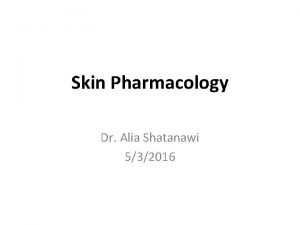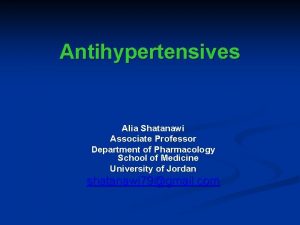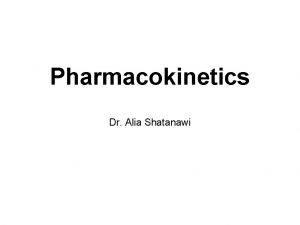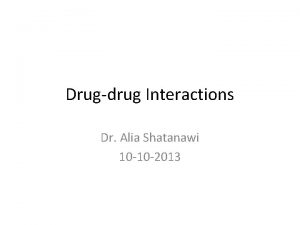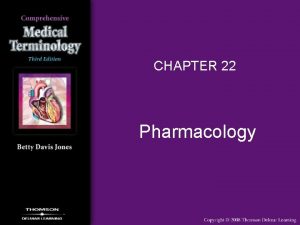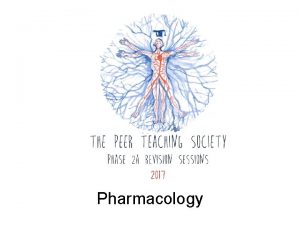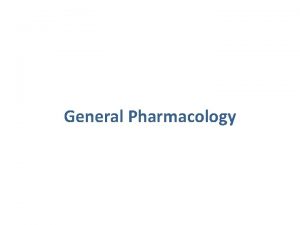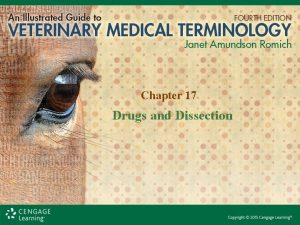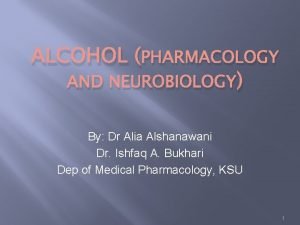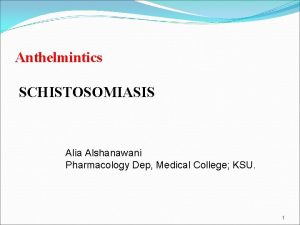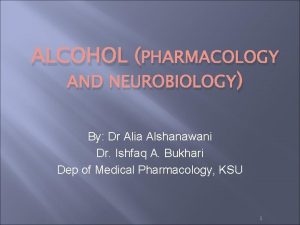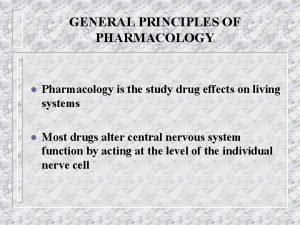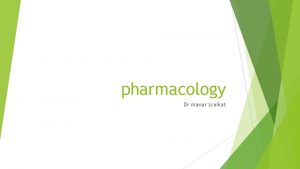Pharmacologic Principles Dr Alia Shatanawi What is Pharmacology





























![Phase II • Phase II: Rx/tx given to larger group [100300] to confirm effectiveness, Phase II • Phase II: Rx/tx given to larger group [100300] to confirm effectiveness,](https://slidetodoc.com/presentation_image_h2/508ec3b03d6a43360ba7eb39c874a5a1/image-30.jpg)


- Slides: 32

Pharmacologic Principles Dr. Alia Shatanawi

What is Pharmacology? Pharmacology is the study of drugs It involves examining the interactions of chemical substances with living systems, with a view to understanding the properties of drugs and their actions, including the interactions between drug molecules and drug receptors and how these interactions elicit an effect.

Pharmacology ■ ■ The study or science of drugs Knowledge of pharmacology allows us to understand how drugs affects humans.

What is your responsibility…. . ■ What drug to order: you need to know the name, intended use, effect on the body, some knowledge of contraindication. ■ How the medication is to be administrated, including dosage ranges. ■ Why the medication has been prescribed for this particular patient. ■ By knowing that the can avoid many series adverse drug effect in your patients.

Naming the drugs ■ Chemical name: atomic/molecular structure ■Generic ❑ ❑ derived from chemical name listed in US Pharmacopedia & Formulary ■Trade ❑ ❑ name selected by Manufacturer copyrighted

Drug Names Chemical Name Generic Name Trade Name 7 -chloro-1, 3 -dihydro-1 methyl-5 phenyl 2 H-1, 4 benzodiazepin 2 -one diazepam Valium→ Ethyl 1 -methyl 4 -pheylisonipecotate hydrochloride meperidine Demerol→ acetylsalicyclic aspirin Ecotrin→

Dosage Forms ■ ■ ■ ■ Tablets Capsules Sustained release tablet Injection – “shot” Sublingual – under the tongue Intravenous - IV or directly into the vein Topical Dr. Shatanawi 2017

Tablet Dr. Shatanawi 2017

Capsules Dr. Shatanawi 2017

Enteric Coated Tablets Dr. Shatanawi 2017

Sublingual Dr. Shatanawi 2017

IM and SC Dr. Shatanawi 2017

Intravenous or IV Dr. Shatanawi 2017

Oral Medications (p. o. ) Pills Must Dissolve/Breakdown Syrups/Suspensions are more rapid onset Most Absorbed in Small Intestine compressed tablet ■ ■ ❑ must be “scored” to divide Dr. Shatanawi 2017

Sustained Release Oral ■ ■ ■ Do Not Break Enteric Coated Beads or Granules Dr. Shatanawi 2017

Sublingual / Buccal ■ ■ ■ Rapid absorption and response Highly vascular areas Avoids “First Liver Bypass” Dr. Shatanawi 2017

Medical Pharmacology Deals with understanding the actions of drugs on individual organisms, especially humans and domestic animals. Both beneficial and toxic effects are included. – Pharmacokinetics deals with the absorption, distribution, and elimination of drugs, i. e. the actions of the body on drugs. – Pharmacodynamics concerns the actions of the drug on the organism. 17

18

The History of Pharmacology Around the end of the 17 th century, and following the example of the physical sciences, reliance on observation and experimentation began to replace theorizing in medicine. As the value of these methods in the study of disease became clear, physicians began to apply them to the effects of traditional drugs used in their own practices. Thus, Materia Medica—the science of drug preparation and the medical use of drugs— began to develop as the precursor to Pharmacology. 19

The History of Pharmacology However, any real understanding of the mechanisms of action of drugs was prevented by the absence of methods for purifying active agents from the crude materials that were available and —even more—by the lack of methods for testing hypotheses about the nature of drug actions. 20

The History of Pharmacology In the late 18 th and early 19 th centuries, methods were developed in experimental physiology and pharmacology. Advances in chemistry and the further development of physiology in the 18 th, 19 th, and early 20 th centuries laid the foundation needed for understanding how drugs work at the organ and tissue levels. 21

The History of Pharmacology As new concepts and new techniques were introduced, information accumulated about drug action and the biologic substrate of that action, the drug receptor. During the last half-century, many fundamentally new drug groups and new members of old groups were introduced. 22

The History of Pharmacology The last three decades have seen an even more rapid growth of information and understanding of the molecular basis for drug action. The molecular mechanisms of action of many drugs have now been identified, and numerous receptors have been isolated, structurally characterized, and cloned. In fact, the use of receptor identification methods has led to the discovery of many Orphan Receptors —receptors for which no ligand has been discovered and whose function can only be thought of. 23

The History of Pharmacology Studies of the local molecular environment of receptors have shown that receptors and effectors do not function in isolation; they are strongly influenced by companion regulatory proteins. 24

The History of Pharmacology Two general principles should be remembered: (1) all substances can under certain circumstances be toxic, and the chemicals in botanicals (herbs and plant extracts) are no different from chemicals in manufactured drugs except for the proportion of impurities. (2) all dietary supplements and all therapies promoted as health-enhancing, should meet the same standards of efficacy and safety as conventional drugs and medical therapies. There should be no artificial separation between scientific medicine and "alternative" or "complementary" medicine. 25

Drugs have been discovered by two approaches Dr. Shatanawi 2017

Drug discovery phase: ■ Serendipity ❑ ❑ ■ Screening ❑ ❑ ■ Penicillin Sildenafil aspirin Statins/HMG Co. A reductase inhibitors Design ❑ ❑ HIV protease inhibitors COX 2 specific inhibitors Dr. Shatanawi 2017

Phases of Clinical Investigation Dr. Shatanawi 2017

Phase I • • When a drug is administered to humans for the first time. Healthy men between 18 and 45 years of age • Can this be applied to all drugs? !!!! • The purpose of phase I studies is to establish the dose level at which signs of toxicity first appear. Dr. Shatanawi 2017
![Phase II Phase II Rxtx given to larger group 100300 to confirm effectiveness Phase II • Phase II: Rx/tx given to larger group [100300] to confirm effectiveness,](https://slidetodoc.com/presentation_image_h2/508ec3b03d6a43360ba7eb39c874a5a1/image-30.jpg)
Phase II • Phase II: Rx/tx given to larger group [100300] to confirm effectiveness, monitor SE, & further evaluate safety Dr. Shatanawi 2017

Phases of Clinical Trials (cont. ) ■ ■ Phase III: New drug given to even larger group [1, 000 -3, 000] to fulfill all of Phase II objectives & compare it to other commonly used txs & collect data that will allow it to be used safely Phase IV: Done after new drug has been marketed - studies continue to test and to collect data about effects in various populations & SE from long term use. Dr. Shatanawi 2017

Summary of Phases I-III # Subs. Length Purpose % Drugs Successfully Tested 20 – 100 Mainly Safety 70% Phase II Up to Several months- 2 yrs. Short term safety; mainly effectiveness 33% Phase III 100 s – 1 -4 yrs. Safety, dosage & 25 -30% effectiveness Phase I several 1000
 Alia shatanawi
Alia shatanawi Alia shatanawi
Alia shatanawi Alia shatanawi
Alia shatanawi Alia shatanawi
Alia shatanawi Therapeutic class and pharmacologic class
Therapeutic class and pharmacologic class Basic principles of pharmacology
Basic principles of pharmacology Basic principles of pharmacology
Basic principles of pharmacology Chapter 30 principles of pharmacology
Chapter 30 principles of pharmacology What is pharmacology
What is pharmacology Alia
Alia Alia atlas
Alia atlas Alia tuqan
Alia tuqan Terminal extubation
Terminal extubation Radio idea
Radio idea Multite
Multite Nur alia file upload
Nur alia file upload Pharmacology definition
Pharmacology definition First pass metabolism
First pass metabolism Therapeutic index
Therapeutic index Define pharmacology
Define pharmacology Pharmacology tutor anderson
Pharmacology tutor anderson Basic & clinical pharmacology
Basic & clinical pharmacology Clinical pharmacology powered by clinicalkey
Clinical pharmacology powered by clinicalkey First pass effect
First pass effect Clinical pharmacology seminar
Clinical pharmacology seminar First order drug elimination
First order drug elimination Maintenance dose formula
Maintenance dose formula Clinical pharmacology residency
Clinical pharmacology residency Toxicology and applied pharmacology
Toxicology and applied pharmacology Respiratory pharmacology quiz
Respiratory pharmacology quiz Diazepa
Diazepa What is ion trapping in pharmacology
What is ion trapping in pharmacology Loading dose example
Loading dose example

